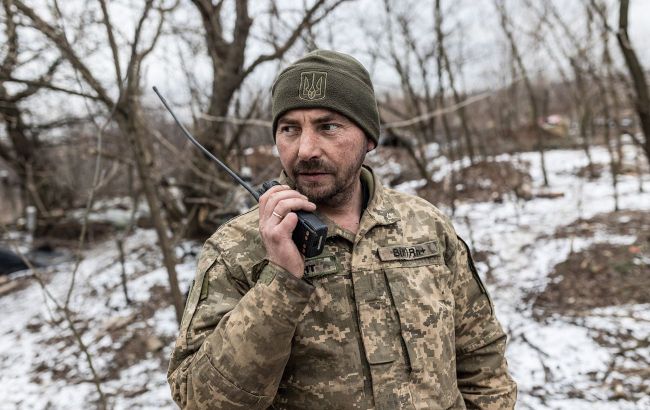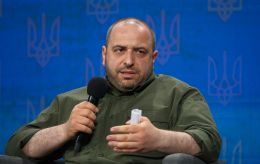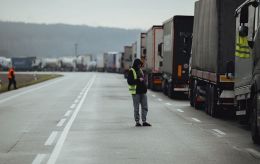Is Ukrainian Pokrovsk at threat of falling, and how situation may unfold for other towns
 Photo: Ukrainian soldier in Donetsk region (Getty Images)
Photo: Ukrainian soldier in Donetsk region (Getty Images)
Russian forces aim to expand control in Donbas. They are close to fully capturing Kurakhove, advancing toward Pokrovsk and Velyka Novosilka, and are likely forming a base for an offensive against the Sloviansk-Kramatorsk agglomeration.
Read about the situation at the beginning of 2025 and how events will develop at the front, in particular in the Kursk region, in RBC-Ukraine's review.
Contents:
- What's happening in Kurakhove and near Velyka Novosilka
- Is there a threat of encirclement of Pokrovsk and where will Russia strike next
- Why Izium and Balakliia are prepared for circular defense
- How long can the Ukrainian Armed Forces hold the foothold in the Kursk region
What's happening in Kurakhove and near Velyka Novosilka
Currently, Russian troops are closing an encirclement of Velyka Novosilka, which is located near the administrative borders of Donetsk, Zaporizhzhia, and Dnipropetrovsk regions. The Russian army has cut off the road from the north near Novyi Komar, while from the south, they have advanced close to heights near Neskuchne and Vremivka.
Capturing Velyka Novosilka would enable the enemy to advance toward the Dnipropetrovsk region. According to the spokesperson of the 48th Separate Artillery Brigade of the Armed Forces of Ukraine, Bohdan Petrenko, achieving this would require significant effort, given that Ukrainian strikes slow down the advance by breaking up personnel at the stage of pickup and drop-off.

Photo: Velyka Novosilka is close to encirclement and an assault on this district center in the Donetsk region may begin soon (deepstatemap.live)
However, military and political analyst of the Information Resistance group, Oleksandr Kovalenko, believes that an assault on Velyka Novosilka could begin in the near future from the eastern and southeastern directions. “But it will be very difficult to accomplish because the settlement is cut off by rivers, which act as natural barriers, creating significant challenges for the Russians,” he explained to RBC-Ukraine.
The goal of the Russians is to quickly move beyond the boundaries of the Donetsk region - not to advance toward Dnipro or launch a major campaign but rather to create a wave of panic and demonstrate, above all to the future US President Donald Trump, that they could potentially advance further, the interlocutor believes.
To the northeast of Velyka Novosilka, they are advancing toward Kurakhove. Since autumn, the enemy has been attempting to encircle the town with two groups from Selydove and Vuhledar, but Ukrainian forces still control the road supplying the remaining garrison of Kurakhove. By the end of December, central parts and the multi-story residential areas were captured, while the Ukrainian troops were pushed back into the industrial zone.

Photo: According to maps, Kurakhove is almost completely captured (deepstatemap.live).
Recently, Russian military bloggers reported the alleged capture of the industrial zone and shared videos featuring a Russian flag. However, there is no verified information from open sources regarding what exactly is happening. Military expert and former spokesperson for the General Staff of the Armed Forces of Ukraine, Vladyslav Seleznov, suggests viewing the situation in Kurakhove through the lens of rearguard fighting - Ukrainian strikes aimed at retreating to prepared positions.
“It’s hard to predict how long the defense will hold. But after Kurakhove, the enemy will likely move west to implement at least part of Vladimir Putin’s plan to reach the administrative boundary of the Donetsk region. Although the administrative boundary won’t become a control point, the movement won’t stop until the Defense Forces stop it,” he noted.
Kovalenko emphasizes that the fall of Kurakhove’s industrial zone isn’t a matter of just a few days and may take longer. There are still exhausting battles ahead for the Russians, as the industrial zone includes not only a thermal power plant but also a mechanical plant, forming a large complex with many buildings.
"For them, closing the Kurakhove salient is very important. Without it, they can’t begin a full-scale advance on Pokrovsk," he added.
Is there a threat of encirclement of Pokrovsk and where will Russia strike next
In December, the enemy cut off the road south of Pokrovsk and tested the possibility of a direct attack, but Ukrainian forces engaged in battles near Shevchenko and forced the enemy to abandon the initial plan. "A week ago, it seemed that the enemy was at a crossroads. It was unclear whether they would launch a frontal assault, as they did with Selydove, or attempt an encirclement strategy," Seleznov said.
Analysts from the Institute for the Study of War (ISW) believe that an immediate assault on Pokrovsk is no longer part of the Russian command's urgent plans. They suggest that Putin may have instructed to postpone the operation and to focus on advancing through open terrain via smaller villages instead.

Photo: The Russian army is leveling the southern front and is not yet able to start a full-fledged battle for Pokrovsk (deepstatemap.live)
Currently, the Russian forces are establishing a static front line from Shevchenko to Krasnyi Yar, clearly adopting tactics of flanking encirclements. As stated by the spokesperson for the Operational-Strategic Group Khortytsia, Viktor Trehubov, they are attempting to encircle Pokrovsk through neighboring villages and settlements, infiltrating in groups, accumulating forces, and striking in ways that aim to bypass the city.
This approach aims to disrupt the logistics of the Pokrovsk garrison along the 0406 and M-30 highways leading to the Dnipropetrovsk region, explains Oleksandr Kovalenko.
"Of course, the Russian command has an obsession with encircling Pokrovsk. But they lack the resources. To encircle Pokrovsk, a force of 100-150,000 personnel would be needed just in this area. Currently, there are around 100,000 troops concentrated in both the Pokrovsk and Kurakhove directions. Therefore, Russian plans cannot be fully realized," he noted.
The situation remains tense in Toretsk and Chasiv Yar, where battles have been ongoing in urban areas for several weeks. Chasiv Yar has seen the main combat along the Siverskyi Donets-Donbas Canal, with a focus on capturing the refractory materials factory. In Toretsk there are head-on fights. While the Defense Forces claim control of the situation, they acknowledge that some positions have been lost due to recent assaults.
Given the increased pressure in the northeastern Donetsk region, Russian forces are likely attempting to establish footholds for an advance toward the Sloviansk-Kramatorsk agglomeration. According to Seleznov, there will likely be at least three such areas - around Chasiv Yar, Kostiantynivka, and from the Lyman direction. The enemy likely intends to initiate this operation during the spring-summer campaign of 2025.
Why Izium and Balakliia are prepared for circular defense
The tense situation continues in the Kharkiv region. In the northern part, Russian forces are assaulting the Vovchansk district, launching strikes, deploying guided bombs, and operating through sabotage groups. The Defense Forces are holding off these advances and preventing them from gaining ground toward Kupiansk.
To the north of Kupiansk, the enemy has crossed the Oskil River near Masiutivka and is expanding a foothold on the western bank. This area is becoming increasingly saturated with Russian infantry, who are establishing positions and gradually advancing into the large settlement of Dvorichna.
Attempts to move personnel across the river by boats are frequently reported, as noted by the spokesperson for the 116th Separate Mechanized Brigade, Andrii Rubtsov. "We are observing attempts by the enemy to cross the Oskil River using inflatable boats. However, given that our UAV pilots are actively monitoring, these attempts have been unsuccessful," he stated.
To the south, Russian forces have reached the Oskil River near Kruhliakivka but have become bogged down attempting to advance in two directions - toward Kupiansk and Borova. However, there remain threats, and Kharkiv Regional Military Administration Head Oleh Syniehubov reported preparations for circular defense in Izium and Balakliia, despite both cities being located on opposite banks.

Photo: Despite the absence of extreme threats, Izium and Balakliia are already being prepared for a circular defense (deepstatemap.live)
The Military Administration is acting proactively, explains Vladyslav Seleznov. "If we assess the enemy's operational capabilities for a spring-summer 2025 offensive on the Sloviansk-Kramatorsk agglomeration, it's clear that in this scenario, Balakliia and Izium would be at risk," he said.
According to Oleksandr Kovalenko, the Regional Military Administration preferred to act "leapfrogging" rather than step by step, especially compared to regions like Dnipropetrovsk.
"Where are Izium and Balakliia, and where is the front line? And how quickly is it advancing toward them? I wouldn't say there's an imminent threat for them yet, but they decided to act preemptively. And that's the right call, because in the Dnipropetrovsk region, unfortunately, the defense wasn’t built as intensively when Russians were approaching Vuhledar, Selydovo, and Kurakhove," the expert emphasized.
Circular defense doesn’t necessarily mean an immediate or critical situation in Izium and Balakliia in the coming weeks or months. The news about Kupiansk’s circular defense emerged nearly a year ago, but during this time, the Russian forces did not make a general attempt to capture the city. "Russians won’t quickly advance on these cities. Could this happen in a year? Possibly, but not guaranteed. However, preparation must be done in advance," Kovalenko noted.
How long can the Ukrainian Armed Forces hold the foothold in the Kursk region
The Russian autumn offensive in the Kursk region did not achieve its objectives. Judging by the plan, the goal was likely to force Ukrainian Defense Forces to retreat under the threat of encirclement into the Sumy region, with attacks along the border from both the west and east. However, in the west, the enemy became bogged down near Novoivanivka, while in the east, they managed to capture Plekhove and cross the Psel River only after involving North Korean troops.
It seems that Ukrainian forces have managed to establish a solid defensive position around Sudzha, and as long as the routes from Sudzha and Sverdlikovo remain under Ukrainian control, the Ukrainian army is able to hold part of the Kursk region.

Photo: Ukraine continues to hold the foothold in the Kursk region, despite the enemy's superiority in forces and means (deepstatemap.live)
The recent developments support this view. On December 30, a Telegram post from the Head of the Presidential Office Andriy Yermak hinted at good news. The next day, the Special Operations Forces reported successful mopping up and retaking a populated area (the specific location wasn’t disclosed). Today, a successful strike on a command post of the Russian 810th Brigade in Maryino became known.
Regarding the Kursk foothold, Vladyslav Seleznov remains cautious in his assessments. "The situation is highly dynamic, and the balance of forces is not in our favor. In such conditions, it’s unrealistic to assume we can indefinitely hold the Kursk region. I assess our actions as a maneuverable defense within the framework of the 2024 strategic defense operation of 2024, which has smoothly transitioned into 2025," he noted.
Oleksandr Kovalenko points out that the Russian force in the area totals around 55,000 troops, with an additional 11,000 reinforcements from North Korea. Clearly, the enemy remains focused on advancing.
"Do we have the capability to maintain our controlled area? Yes. Despite the numerical superiority of Russian forces and the involvement of North Korean troops. The intermediate outcome is clear — Russia won’t meet Putin’s deadline to reclaim the Kursk region before Donald Trump’s inauguration (by January 20 - ed.). At this point, they do not have that capability," concluded the expert.
Sources: reports of the General Staff of the Ukrainian Armed Forces, analytics of the Institute for the Study of War (ISW), DeepState maps, statements of military speakers, and comments by experts Vladyslav Seleznov and Oleksandr Kovalenko.

